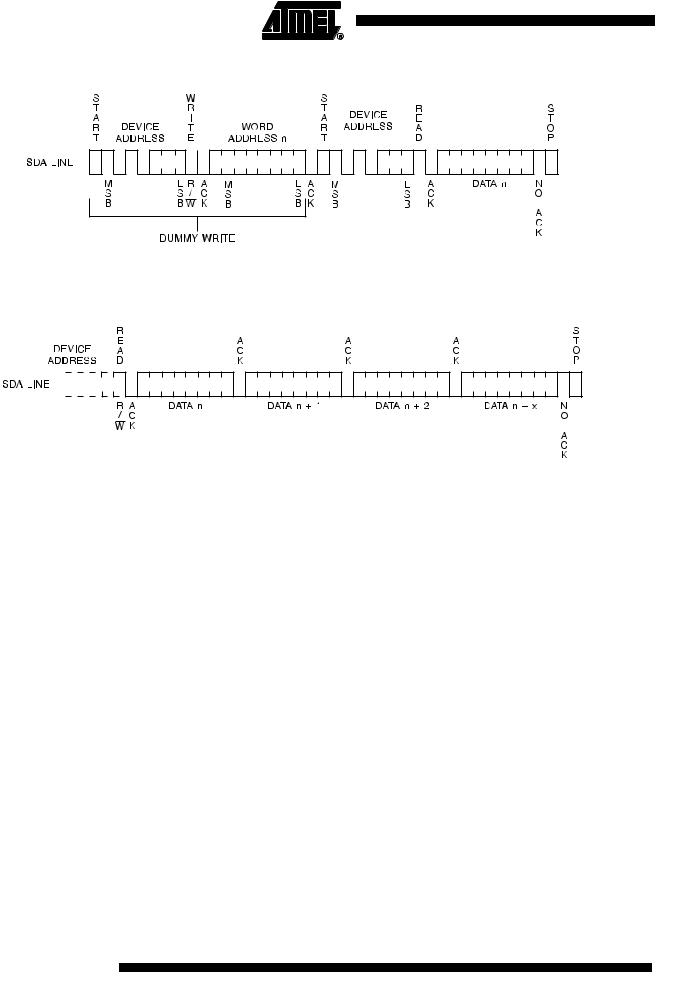

Device Operation
CLOCK and DATA TRANSITIONS: The SDA pin is normally pulled high with an external device. Data on the SDA pin may change only during SCL low time periods (see Figure 4 on page 7). Data changes during SCL high periods will indicate a start or stop condition as defined below.
START CONDITION: A high-to-low transition of SDA with SCL high is a start condition which must precede any other command (see Figure 5 on page 8).
STOP CONDITION: A low-to-high transition of SDA with SCL high is a stop condition. After a read sequence, the stop command will place the EEPROM in a standby power mode (see Figure 5 on page 8).
ACKNOWLEDGE: All addresses and data words are serially transmitted to and from the EEPROM in 8-bit words. The EEPROM sends a zero to acknowledge that it has received each word. This happens during the ninth clock cycle.
STANDBY MODE: The AT24C02B features a low-power standby mode which is enabled: (a) upon power-up and (b) after the receipt of the STOP bit and the completion of any internal operations.
MEMORY RESET: After an interruption in protocol, power loss or system reset, any 2- wire part can be reset by following these steps:
1.Clock up to 9 cycles.
2.Look for SDA high in each cycle while SCL is high.
3. Create a start condition.
6 AT24C02B
5126B–SEEPR–10/05

AT24C02B
Bus Timing
Figure 2. SCL: Serial Clock, SDA: Serial Data I/O
Write Cycle Timing
Figure 3. SCL: Serial Clock, SDA: Serial Data I/O
SCL
SDA |
8th BIT |
ACK |
|
|
|
|
|
|
|
|||
|
WORDn |
|
|
|
|
|
|
|
|
|
|
|
|
|
|
|
|
|
|
|
|
|
|
|
|
|
|
|
|
|
|
(1) |
|
|
|
|
|
|
|
|
|
|
|
|
twr |
|
|
|
|
|
|
|
|
|
|
STOP |
START |
|||||||
|
|
|
|
|
||||||||
|
|
|
CONDITION |
|
CONDITION |
|||||||
Note: 1. |
The write cycle time tWR is the time from a valid stop condition of a write sequence to the end of the internal clear/write cycle. |
|||||||||||
Figure 4. Data Validity
7
5126B–SEEPR–10/05

Figure 5. Start and Stop Definition
Figure 6. Output Acknowledge
8 AT24C02B
5126B–SEEPR–10/05

 AT24C02B
AT24C02B
Device Addressing
Write Operations
Read Operations
The 2K EEPROM device requires an 8-bit device address word following a start condition to enable the chip for a read or write operation (refer to Figure 7).
The device address word consists of a mandatory one, zero sequence for the first four most significant bits as shown. This is common to all the EEPROM devices.
The next 3 bits are the A2, A1 and A0 device address bits for the 2K EEPROM. These 3 bits must compare to their corresponding hard-wired input pins.
The eighth bit of the device address is the read/write operation select bit. A read operation is initiated if this bit is high and a write operation is initiated if this bit is low.
Upon a compare of the device address, the EEPROM will output a zero. If a compare is not made, the chip will return to a standby state.
BYTE WRITE: A write operation requires an 8-bit data word address following the device address word and acknowledgment. Upon receipt of this address, the EEPROM will again respond with a zero and then clock in the first 8-bit data word. Following receipt of the 8-bit data word, the EEPROM will output a zero and the addressing device, such as a microcontroller, must terminate the write sequence with a stop condition. At this time the EEPROM enters an internally timed write cycle, tWR, to the nonvolatile memory. All inputs are disabled during this write cycle and the EEPROM will not respond until the write is complete (see Figure 8 on page 11).
PAGE WRITE: The 2K EEPROM is capable of an 8-byte page write.
A page write is initiated the same as a byte write, but the microcontroller does not send a stop condition after the first data word is clocked in. Instead, after the EEPROM acknowledges receipt of the first data word, the microcontroller can transmit up to seven data words. The EEPROM will respond with a zero after each data word received. The microcontroller must terminate the page write sequence with a stop condition (see Figure 9 on page 11).
The data word address lower three bits are internally incremented following the receipt of each data word. The higher data word address bits are not incremented, retaining the memory page row location. When the word address, internally generated, reaches the page boundary, the following byte is placed at the beginning of the same page. If more than eight data words are transmitted to the EEPROM, the data word address will “roll over” and previous data will be overwritten.
ACKNOWLEDGE POLLING: Once the internally timed write cycle has started and the EEPROM inputs are disabled, acknowledge polling can be initiated. This involves sending a start condition followed by the device address word. The read/write bit is representative of the operation desired. Only if the internal write cycle has completed will the EEPROM respond with a zero allowing the read or write sequence to continue.
Read operations are initiated the same way as write operations with the exception that the read/write select bit in the device address word is set to one. There are three read operations: current address read, random address read and sequential read.
CURRENT ADDRESS READ: The internal data word address counter maintains the last address accessed during the last read or write operation, incremented by one. This address stays valid between operations as long as the chip power is maintained. The address “roll over” during read is from the last byte of the last memory page to the first
9
5126B–SEEPR–10/05

byte of the first page. The address “roll over” during write is from the last byte of the current page to the first byte of the same page.
Once the device address with the read/write select bit set to one is clocked in and acknowledged by the EEPROM, the current address data word is serially clocked out. The microcontroller does not respond with an input zero but does generate a following stop condition (see Figure 10 on page 11).
RANDOM READ: A random read requires a “dummy” byte write sequence to load in the data word address. Once the device address word and data word address are clocked in and acknowledged by the EEPROM, the microcontroller must generate another start condition. The microcontroller now initiates a current address read by sending a device address with the read/write select bit high. The EEPROM acknowledges the device address and serially clocks out the data word. The microcontroller does not respond with a zero but does generate a following stop condition (see Figure 11 on page 12).
SEQUENTIAL READ: Sequential reads are initiated by either a current address read or a random address read. After the microcontroller receives a data word, it responds with an acknowledge. As long as the EEPROM receives an acknowledge, it will continue to increment the data word address and serially clock out sequential data words. When the memory address limit is reached, the data word address will “roll over” and the sequential read will continue. The sequential read operation is terminated when the microcontroller does not respond with a zero but does generate a following stop condition (see Figure 12 on page 12).
10 AT24C02B
5126B–SEEPR–10/05

AT24C02B
Figure 7. Device Address
Figure 8. Byte Write
Figure 9. Page Write
Figure 10. Current Address Read
11
5126B–SEEPR–10/05

Figure 11. Random Read
Figure 12. Sequential Read
12 AT24C02B
5126B–SEEPR–10/05

AT24C02B
AT24C02B Ordering Information(1)
Ordering Code |
Package |
Operation Range |
|
|
|
|
|
AT24C02B-10PU-1.8(2) |
8P3 |
|
|
AT24C02BN-10SU-1.8(2) |
8S1 |
Lead-free/Halogen-free/ |
|
AT24C02B-10TU-1.8(2) |
8A2 |
||
Industrial Temperature |
|||
AT24C02BY6-10YH-1.8(3) |
8Y6 |
||
(–40°C to 85°C) |
|||
AT24C02B-10TSU-1.8(2) |
5TS1 |
||
|
|||
AT24C02BU3-10UU-1.8(2) |
8U3-1 |
|
|
AT24C02B-W1.8-11(4) |
Die Sale |
Industrial Temperature |
|
|
|
(–40°C to 85°C) |
|
|
|
|
Notes: 1. For 2.7V devices used in the 4.5V to 5.5V range, please refer to performance values in the AC and DC characteristics table. 2. “U” designates Green Package & RoHS compliant.
3. “H” designates Green Package & RoHS compliant with NiPdAu lead finish.
4.Available in waffle pack and wafer form; order as SL788 for inkless wafer form. Bumped die available upon request. Please contact Serial EEPROM Marketing.
|
Package Type |
|
|
8P3 |
8-lead, 0.300" Wide, Plastic Dual Inline Package (PDIP) |
|
|
8S1 |
8-lead, 0.150" Wide, Plastic Gull Wing Small Outline (JEDEC SOIC) |
|
|
8A2 |
8-lead, 4.4 mm Body, Plastic Thin Shrink Small Outline Package (TSSOP) |
|
|
8Y6 |
8-lead, 2.0 mm x 3.00 mm Body, 0.50 mm Pitch, Ultra Thin Mini-MAP, Dual No Lead Package (DFN), (MLP 2x3 mm) |
|
|
5TS1 |
5-lead, 2.90 mm x 1.60 mm Body, Plastic Thin Shrink Small Outline Package (SOT23) |
|
|
8U3-1 |
8-ball, die Ball Grid Away Package (dBGA2) |
|
|
|
Options |
|
|
–1.8 |
Low-voltage (1.8V to 5.5V) |
|
|
13
5126B–SEEPR–10/05
